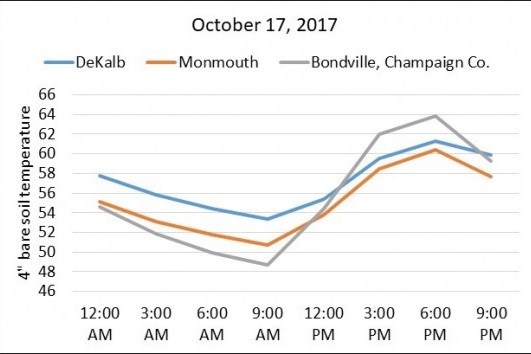By Emerson Nafziger
The substantial rain that fell over central and northern Illinois between October 5 and 15 mostly soaked into the soil that was dried out by crop water use, and harvest has moved back to full speed in most areas. With harvest, thoughts turn to application of fall ammonia in central and northern Illinois. Almost everyone is on board with waiting until soil temperatures are at or below 50 degrees before applying ammonia. Cool soil (along with use of nitrification inhibitor) lowers the rate of nitrification, so helps preserve N in the ammonium form. Nitrogen present in the soil as ammonium is safe from loss.
Once air and soil temperatures start to decline in October, it’s natural to anticipate that soil temperatures will reach 50 soon, so some are inclined to start to apply before soil temperatures reach 50 degrees. But if we apply when soil is at 60 degrees and soil temperatures fail to drop quickly, or if they rise again after application, nitrification will continue and will persist as long as soils stay warmer. In fact, nitrification does not stop dead at 50 degrees; as a biological process, its rate drops off as temperature falls, but temperatures need to near freezing for nitrification to stop completely.
So we need to wait to apply fall ammonia not only until soil temperatures are 50 or less, but until we have reasonable confidence that they’ll stay there. In Illinois, we normally consider November 1 to be the date at which we can be reasonably sure that soil temperatures won’t rise again until the next spring. That’s not a sure thing, however – in both of the past two years, soil temperatures have gone above 50 at least once between November and February. But most years it’s a reasonable starting date to balance keeping N safe with getting fall application done.
Minimum air temperatures have fallen into the 40s this past week, which has people wondering if it might be OK to go ahead and start applying now. Minimum soil temperatures 4 inches deep under bare soil (from the Illinois Water Survey http://www.isws.illinois.edu/warm/soil) have dropped to the upper 40s to low 50s over much of the state each day between October 16 and 18 this week. The problem with using only the minimum soil temperature is that it doesn’t represent the actual soil temperature in the ammonia application zone. As Figure 1 shows, minimum soil temperatures (on clear days) are typically five degrees or so less than average soil temperatures for the day. So even though we may need a jacket on cool mornings this week, ammonia applied now is not going to be in soils with temperatures less than 50 degrees for some days or weeks.

Figure 1. Soil temperature at 4 inches under bare soil at three Illinois Climate Network sites on October 17, 2017. Source: Illinois State Water Survey.
Air temperatures are forecast to stay in the 70s the rest of this week, to fall into the 50s (with lows in the mid to upper 30s) next week, then to rise again (with dry weather) for some period after that. We’re already past the average first frost date for central and northern Illinois, and even with more seasonal temperatures coming the last week of October, it doesn’t look like ammonia applied now will be as safe from nitrification and possible loss as will ammonia applied in November.
If the soil is in condition to apply ammonia, soil temperatures are in the upper 40s, and the 10-day forecast doesn’t show above-normal temperatures settling in, the last few days of October might offer an opportunity to start applying ammonia. But what if early November is warmer than normal, and soil temperatures remain above 50? Delaying application, of course, moves us closer to having safer soil temperatures.
Average Illinois fall temperatures have been trending slowly upward for some decades now, and as we have seen the last few years, waiting until November 1 does not assure low soil temperatures as consistently as it did in the past. So if a stretch of warm weather is still in the forecast at the end of October, it might make sense to wait a little longer. Otherwise, patience in waiting another 10 days will likely be rewarded, even if – as is often be the case when doing the right thing – the reward isn’t very visible.